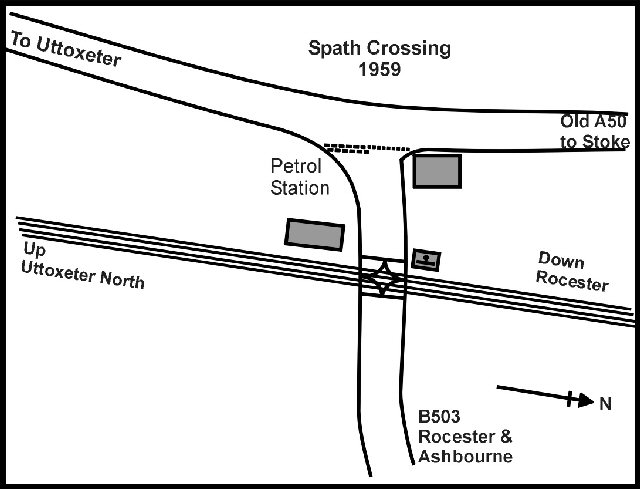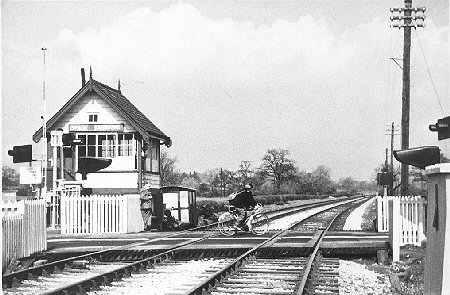
Diagram of Spath Crossing prior to Modernisation

Sam Hallas' Website
Britain's First Automatic Level Crossing
As it stood in 1959, Spath was where the B5030 Uttoxeter to Ashbourne road crossed the Churnet Valley branch of the former North Staffordshire Railway. The line speed at Spath was a modest 45mph and there was a falling gradient of 1 in 396 in the Up direction. The LMR reported that there were 30 trains passing the box each week day.
The crossing was gated and was supervised by a small cabin of the NSR's second design which stood on the Down side to the north of the road. The box was equipped with a 10 lever frame of which four were spare. The four interlocking gates were worked from a wheel in the box and the wickets were locked by the frame. The layout was, and always had been, plain line.
The Sectional Appendix extract [opens new window] gives an idea as to the railway geography of the area.
Although not directly relevant to the story in hand, the operation of the intermediate Level Crossings mentioned in the Sectional Appendix is interesting, not least of which because they seem to have been totally ignored in the plans for Spath Crossing.
Seven Acres level crossing is referred to on the plans for Spath as "Cotton Mill level crossings" (note the plural). Warning bells were provided, manually operated from Spath and Uttoxeter North cabins. A warning notice was located on either side of each crossing; "When this bell is ringing trains are approaching this crossing". The hand gates were kept padlocked.
At Crakemarsh crossing warning bells were operated by treadles. While the wickets were uncontrolled, the hand gates were operated by a resident female crossing keeper. Crossing keeper's block indicators were provided.
The boxes on either side were much bigger affairs with Rocester having a 36 lever frame and Uttoxeter North Junction, which controlled one corner of a triangular junction, had 29 levers including nine spares. It was to be Uttoxeter North which would take over supervision of Spath barriers.
Turning to the road layout at Spath, this wasn't as simple as I suspect the Ministry would have hoped for in a pioneering installation. The Uttoxeter bound approach was reasonably straight with 250 yards of view. On the other side, however, there was a busy T-junction a mere 100 yards from the crossing with buildings on the corner. This was aggravated the railway and the road crossing one another at a slight skew and by the crossing itself forming something of a hump restricting views across the railway
.
Diagram of Spath Crossing prior to Modernisation
This T-junction was to prove problematical later on, but in the early days the Ministry didnít seem at all concerned that they were exceeding the limits on traffic volume they had themselves dictated in early guidelines for automating crossings.

Spath Signal Box after modernisation looking in the Down direction towards Rocester Ė Nick Allsop Collection.
The LMR had carried out two traffic surveys;
| 10/16th August 1958 (7 days) Summarised, the average daily user is as follows: | |
| Motor vehicles | 1,517 |
| Motor cycles | 161 |
| Bicycles | 157 |
| Pedestrians | 62 |
| Animals | 7 |
| Horse drawn vehicles | (total of 3 in week) |
| Trains | 26 |
| Note; the above figures do not include road traffic which passed during the 18 hours 40 minutes when the signalbox was closed at the weekend | |
| 6/11th October 1958 (6 days) Summarised, the average daily user is as follows:- | |
| Motor vehicles | 1,300 |
| Motor cycles | 138 |
| Bicycles | 163 |
| Pedestrians | 40 |
| Unaccompanied children | 12 |
| Flocks of sheep | 2 in week) |
| Herds of cattle | 1 in week) |
| Horse riders | 4 in week) |
| Horses | 2 in week) |
| Horse drawn vehicles | 1 |
| Trains | 34 |
There was a footnote to the survey pointing out that "in the Summer, particularly at holiday times, road traffic is sometimes heavier than usual because of visitors to Alton Towers".
It is clear that, come what may, this request from the LMR was going to get approval. An internal minute dated 8th May 1959, in response to the letter from the LMR reads; "This appears to be an excellent crossing for an experiment with automatic half barriers. The number of motor vehicles is slightly higher than we had in mind for the first experimental equipment but we feel that this is more than compensated for by the fact that there are few trains and that the speed of trains is slow. visibility is also good". This trade-off between road traffic and rail traffic was to become enshrined in the criteria for all future installations.
Text © Dave Harris. Photos: as attributed. Diagram: Redrawn SMH 2004